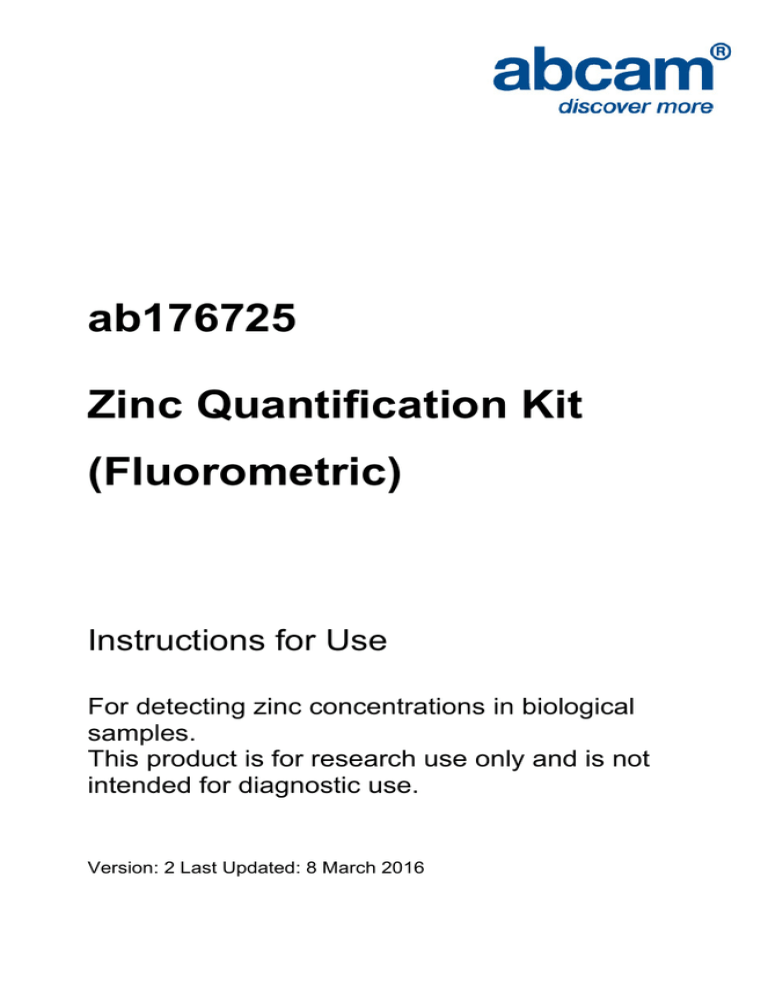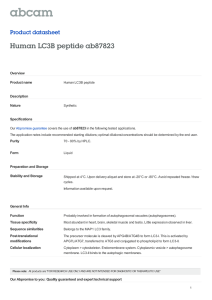
ab176725
Zinc Quantification Kit
(Fluorometric)
Instructions for Use
For detecting zinc concentrations in biological
samples.
This product is for research use only and is not
intended for diagnostic use.
Version: 2 Last Updated: 8 March 2016
Table of Contents
Table of Contents
1
1.
Overview
2
2.
Protocol Summary
3
3.
Kit Components
4
4.
Storage and Stability
4
5.
Materials Required, Not Supplied
5
6.
Assay Protocol
5
7.
Data Analysis
8
8.
Troubleshooting
9
1
1. Overview
Zinc is an essential trace mineral element that plays an important
role in a number of biological processes. It is an essential factor
required for many enzymes, protein structures, and control of genetic
expression. Zinc status also affects basic processes of cell division,
growth, differentiation, development, and aging. Clinical signs of zinc
deficiency include acrodermatitis, low immunity, diarrhoea, poor
healing, stunting, hypogonadism, fetal growth failure, teratology and
abortion. Simple, direct and automation-ready procedures for
measuring zinc ion are highly desirable in research and drug
discovery.
Abcam’s Zinc Quantification Kit (Fluorometric) (ab176725 provides a
robust method for detecting zinc concentration in biological samples
using our proprietary Zn Detector, in which Zinc binds to the probe
with enhanced fluorescence at Ex/Em= 485/525 nm. The Zinc probe
exhibits a large increase in fluorescence in response to Zn2+ (greater
than 200~300 folds). It has high Zn2+ -specificity with little responses
to other metals, including Ca2+, Mg2+, Mn2+, and Cu2+. The assay can
be used with biological samples such as serum, plasma, and urine
with detection sensitivity at 0.2 µM (13 ng/mL).
2
2. Protocol Summary
Add Test samples and Zinc standard
Add Zinc Probe Reagent
Incubate at RT for 5 - 10 min
Monitor fluorescence intensity at Ex/Em = 485/525 nm
3
3. Kit Components
Item
Quantity
Storage
upon
arrival
Storage
after use
Zn Detector
1 vial
-20°C
-20°C
Assay Buffer
15 mL
-20°C
-20°C
ZnCl2 Standard
1 vial
-20°C
-20°C
4. Storage and Stability
Upon arrival, store the kit at-20°C and protected from light. Please
read the entire protocol before performing the assay. Avoid repeated
freeze/thaw cycles.
Warm all buffers to room temperature before use. Briefly centrifuge
all small vials prior to opening.
4
5. Materials Required, Not Supplied
96 or 384-well black plate
Multi-well fluorescence plate reader
6. Assay Protocol
1. ZnCl2 standards and test samples preparations:
a)
Add 10 µL of 100 mM ZnCl2 Standard into 990 µL Assay
Buffer to get 1 mM ZnCl2 standard solution.
b)
Add 100 µL of 1 mM Zinc Standard solution to 900 µL
Assay Buffer to get 100 µM ZnCl2 Standard solution.
c)
Take 300 μL of 100 µM ZnCl2 standard solution (from Step
1b) to perform 1:3 serial dilutions to get 30, 10, 3, 1, 0.3, 0.1
and 0 µM serially diluted ZnCl2 standards.
d)
Dilute the test sample to 5-100 µM range with Assay Buffer.
e)
Add 50 μL of ZnCl2 standards, diluted sample and control
into each well as shown in Table 1.
2. Sample preparation
a)
Cell lysates and tissue extracts:
Lyse cells or homogenize tissues with an EDTA-free lysis buffer,
and centrifuge to get rid of the cell debris. Deproteinized cell
lysate by adding equal volume of the 7% TCA solution to the
5
sample. Spin the mixture for 5 minutes and use the supernatant,
and then adjust pH to 3-4.
b)
Urine samples:
Add some 1.0~6.0 N HCl to urine samples to adjust pH to 3~ 4.
c) Other liquid samples (Cell culture media, serum and other
biological fluids):
Liquid samples can be directly used in the assay. However, samples
that contain significant amounts of protein should be deproteinized
prior the assay. (Please refer to 2a) to deproteinize.)
Samples prepared should be clear and free of turbidity or
precipitates with pH of 3~7. Prior to assay, samples can be diluted
in Assay Buffer in 5-100uM so that the reading will be within the
standard curve range.
3. Run Zinc assay
a)
Add 25 μL of Zn Detector into 5 mL Assay Buffer to make
Zn assay buffer. Add 50 μL Zn assay buffer to each well of
ZnCl2 standard, blank control, and test samples (see Step
1e Table 1) to make the total ZnCl2 assay volume of100
µL/well. Note: For a 384-well plate, add 25 μL of samples
and 25 μL of assay reaction mixture into each well.
6
BL
Zn 1
Zn 2
Zn 3
Zn 4
Zn 5
Zn 6
Zn 7
BL
Zn 1
Zn 2
Zn 3
Zn 4
Zn 5
Zn 6
Zn 7
TS
….
TS
….
….
….
….
….
NOTE: Zn= Zinc Standards, BL = Blank Control, TS = Test Samples.
b)
Incubate the reaction for 5-10 minutes at room temperature,
protected from light.
c)
Monitor the fluorescence increase with a fluorescence plate
reader at Ex/Em = 485/525 nm.
7
7. Data Analysis
Figure 1. ZnCl2 dose response was measured on a 96-well black
plate with the Abcam Zinc Quantification Kit (Fluorometric)
(ab176725). As low as ~ 0.2 µM Zn2+ can be detected with 5 minutes
incubation time (n=3).
8
8. Troubleshooting
Problem
Reason
Solution
Assay not
working
Assay buffer at
wrong temperature
Assay buffer must not be chilled
- needs to be at RT
Protocol step missed
Plate read at
incorrect wavelength
Unsuitable microtiter
plate for assay
Unexpected
results
Re-read and follow the protocol
exactly
Ensure you are using
appropriate reader and filter
settings (refer to datasheet)
Fluorescence: Black plates
(clear bottoms);
Luminescence: White plates;
Colorimetry: Clear plates.
If critical, datasheet will indicate
whether to use flat- or U-shaped
wells
Measured at wrong
wavelength
Use appropriate reader and filter
settings described in datasheet
Samples contain
impeding substances
Unsuitable sample
type
Sample readings are
outside linear range
Troubleshoot and also consider
deproteinizing samples
Use recommended samples
types as listed on the datasheet
Concentrate/ dilute samples to
be in linear range
9
Problem
Reason
Solution
Samples
with
inconsistent
readings
Unsuitable sample
type
Refer to datasheet for details
about incompatible samples
Use the assay buffer provided
(or refer to datasheet for
instructions)
Samples prepared in
the wrong buffer
Samples not
deproteinized (if
indicated on
datasheet)
Cell/ tissue samples
not sufficiently
homogenized
Too many freezethaw cycles
Samples contain
impeding substances
Samples are too old
or incorrectly stored
Lower/
Higher
readings in
samples
and
standards
Not fully thawed kit
components
Out-of-date kit or
incorrectly stored
reagents
Reagents sitting for
extended periods on
ice
Incorrect incubation
time/ temperature
Incorrect amounts
used
Use the 10kDa spin column
(ab93349)
Increase sonication time/
number of strokes with the
Dounce homogenizer
Aliquot samples to reduce the
number of freeze-thaw cycles
Troubleshoot and also consider
deproteinizing samples
Use freshly made samples and
store at recommended
temperature until use
Wait for components to thaw
completely and gently mix prior
use
Always check expiry date and
store kit components as
recommended on the datasheet
Try to prepare a fresh reaction
mix prior to each use
Refer to datasheet for
recommended incubation time
and/ or temperature
Check pipette is calibrated
correctly (always use smallest
volume pipette that can pipette
entire volume)
10
Problem
Reason
Solution
Standard
curve is not
linear
Not fully thawed kit
components
Wait for components to thaw
completely and gently mix prior
use
Pipetting errors when
setting up the
standard curve
Incorrect pipetting
when preparing the
reaction mix
Air bubbles in wells
Concentration of
standard stock
incorrect
Errors in standard
curve calculations
Use of other
reagents than those
provided with the kit
Try not to pipette too small
volumes
Always prepare a master mix
Air bubbles will interfere with
readings; try to avoid producing
air bubbles and always remove
bubbles prior to reading plates
Recheck datasheet for
recommended concentrations of
standard stocks
Refer to datasheet and re-check
the calculations
Use fresh components from the
same kit
11
12
13
14
UK, EU and ROW
Email: technical@abcam.com | Tel: +44(0)1223-696000
Austria
Email: wissenschaftlicherdienst@abcam.com | Tel: 019-288-259
France
Email: supportscientifique@abcam.com | Tel: 01-46-94-62-96
Germany
Email: wissenschaftlicherdienst@abcam.com | Tel: 030-896-779-154
Spain
Email: soportecientifico@abcam.com | Tel: 911-146-554
Switzerland
Email: technical@abcam.com
Tel (Deutsch): 0435-016-424 | Tel (Français): 0615-000-530
US and Latin America
Email: us.technical@abcam.com | Tel: 888-77-ABCAM (22226)
Canada
Email: ca.technical@abcam.com | Tel: 877-749-8807
China and Asia Pacific
Email: hk.technical@abcam.com | Tel: 108008523689 (中國聯通)
Japan
Email: technical@abcam.co.jp | Tel: +81-(0)3-6231-0940
www.abcam.com | www.abcam.cn | www.abcam.co.jp
Copyright © 2015 Abcam, All Rights Reserved. The Abcam logo is a registered trademark.
All information / detail is correct at time of going to print.
15
Copyright © 2013 Abcam, All Rights Reserved. The Abcam logo is a registered trademark.
All information / detail is correct at time of going to print.

![Anti-DR4 antibody [B-N28] ab59481 Product datasheet Overview Product name](http://s2.studylib.net/store/data/012243732_1-814f8e7937583497bf6c17c5045207f8-300x300.png)

![Anti-FAT antibody [Fat1-3D7/1] ab14381 Product datasheet Overview Product name](http://s2.studylib.net/store/data/012096519_1-dc4c5ceaa7bf942624e70004842e84cc-300x300.png)
